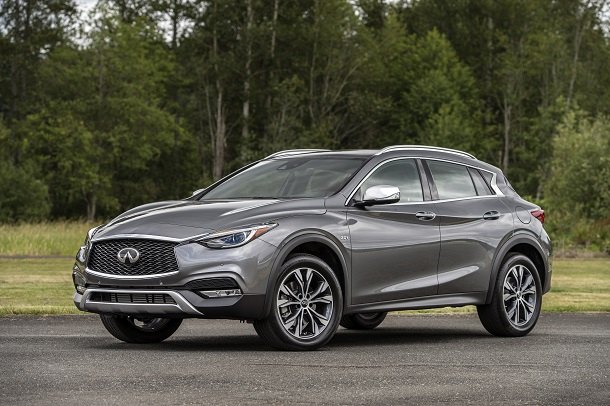Report Points to Product Turmoil in the Nissan-Daimler Partnership

A report in a Japanese business publication claims the partnership that gave us the Infiniti QX30 crossover — built on the same MFA platform as the Mercedes-Benz GLA — won’t yield a compact Infiniti luxury car, as was planned.
This isn’t a case of bad blood between the two automakers, however. The United States just isn’t a ripe target for such a vehicle anymore, apparently, and the vastly uncertain trade situation doesn’t help.
The report in Nikkan Kogyo, picked up by Automotive News, claims America’s thirst for light trucks and increasing disdain for passenger cars brought the project to a screeching halt. Trade was another strong consideration for executives, the report stated. The unnamed model was to be built at the joint Nissan-Daimler assembly plant in Aguascalientes, Mexico.
You can see the problem here — a pricey vehicle in an increasingly difficult segment facing the prospect of being saddled with import duties. Hardly a product execs could confortable go through with.
While Nissan wouldn’t comment on the supposedly kiboshed vehicle, Infiniti spokesman Trevor Hale told Automotive News, “The cooperation between the Renault-Nissan-Mitsubishi Alliance and Daimler is solid and we continue to reap the benefits of our successful cooperation, which includes a number of R&D and manufacturing initiatives around the world.”
The Aguascalientes facility (known as the COMPAS plant) opened last year, and currently builds the next-generation QX50. That model rides atop a jointly-developed platform. It was both automaker’s intent to produce next-generation luxury small cars at the facility.
In January of 2017, a Reuters report revealed signs of cold feet at Nissan. According to sources close to both companies, the automaker reportedly suspended work on Infiniti vehicles sharing Mercedes-Benz’s new MFA2 platform, which first appears in the upcoming A-Class sedan and (for Canadian customers) hatch. The new platform will underpin the next-gen Mercedes-Benz GLA and other small cars (B-class, CLA).
However, a source told Reuters that high technology costs made Nissan think again.
“It wasn’t possible to close a deal on the basis of MFA2,” said the informant. “The targets set by Infiniti were too difficult to achieve.”
[Image: Nissan]

More by Steph Willems
Latest Car Reviews
Read moreLatest Product Reviews
Read moreRecent Comments
- Redapple2 Love the wheels
- Redapple2 Good luck to them. They used to make great cars. 510. 240Z, Sentra SE-R. Maxima. Frontier.
- Joe65688619 Under Ghosn they went through the same short-term bottom-line thinking that GM did in the 80s/90s, and they have not recovered say, to their heyday in the 50s and 60s in terms of market share and innovation. Poor design decisions (a CVT in their front-wheel drive "4-Door Sports Car", model overlap in a poorly performing segment (they never needed the Altima AND the Maxima...what they needed was one vehicle with different drivetrain, including hybrid, to compete with the Accord/Camry, and decontenting their vehicles: My 2012 QX56 (I know, not a Nissan, but the same holds for the Armada) had power rear windows in the cargo area that could vent, a glass hatch on the back door that could be opened separate from the whole liftgate (in such a tall vehicle, kinda essential if you have it in a garage and want to load the trunk without having to open the garage door to make room for the lift gate), a nice driver's side folding armrest, and a few other quality-of-life details absent from my 2018 QX80. In a competitive market this attention to detai is can be the differentiator that sell cars. Now they are caught in the middle of the market, competing more with Hyundai and Kia and selling discounted vehicles near the same price points, but losing money on them. They invested also invested a lot in niche platforms. The Leaf was one of the first full EVs, but never really evolved. They misjudged the market - luxury EVs are selling, small budget models not so much. Variable compression engines offering little in terms of real-world power or tech, let a lot of complexity that is leading to higher failure rates. Aside from the Z and GT-R (low volume models), not much forced induction (whether your a fan or not, look at what Honda did with the CR-V and Acura RDX - same chassis, slap a turbo on it, make it nicer inside, and now you can sell it as a semi-premium brand with higher markup). That said, I do believe they retain the technical and engineering capability to do far better. About time management realized they need to make smarter investments and understand their markets better.
- Kwik_Shift_Pro4X Off-road fluff on vehicles that should not be off road needs to die.
- Kwik_Shift_Pro4X Saw this posted on social media; “Just bought a 2023 Tundra with the 14" screen. Let my son borrow it for the afternoon, he connected his phone to listen to his iTunes.The next day my insurance company raised my rates and added my son to my policy. The email said that a private company showed that my son drove the vehicle. He already had his own vehicle that he was insuring.My insurance company demanded he give all his insurance info and some private info for proof. He declined for privacy reasons and my insurance cancelled my policy.These new vehicles with their tech are on condition that we give up our privacy to enter their world. It's not worth it people.”


































Comments
Join the conversation
The QX50 DOES NOT ride upon a jointly developed platform. It's riding on an upgraded platform that Nissan uses across its small/midsize FWD offerings. The future of Infiniti is largely FWD.
Nothing says Japanese luxury more than Mexican assembly.